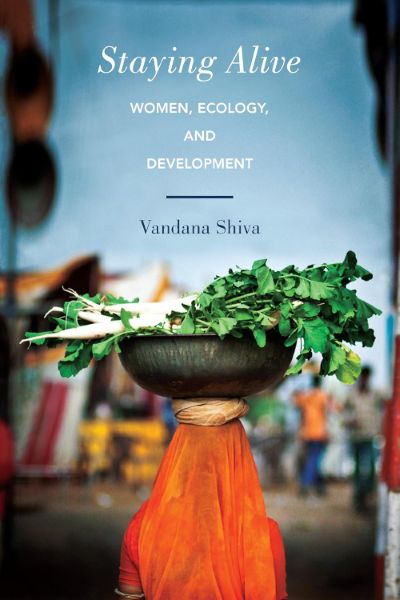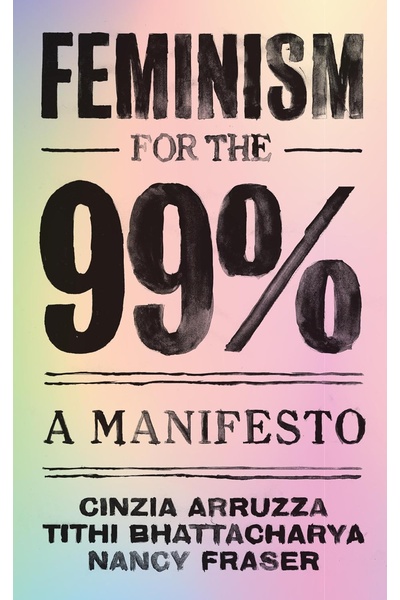Staying Alive: Women, Ecology and Survival in India
This foundational work of ecofeminism reveals how the development paradigm threatens survival itself through violence against nature and women. Through the experiences and perspectives of rural Indian women, Shiva demonstrates how patriarchal development models simultaneously destroy ecosystems and marginalize women, arguing for women's central role as biodiversity custodians in ecological regeneration.

📝 Book Review
In 1988, Vandana Shiva published “Staying Alive: Women, Ecology and Survival in India,” a work that is not only a milestone in ecofeminist theory but a fundamental critique of the Western development model. As a physicist turned environmental activist and scholar, Shiva combined scientific training, feminist analysis, and deep understanding of Indian rural realities to create a revolutionary framework for understanding the relationship between women, nature, and development. This work became a foundational text for the global ecofeminist movement, profoundly influencing our understanding of the intersection between environmental crisis and gender justice.
The Urgent Context of Theoretical Innovation
Shiva wrote this book against the backdrop of ecological and social crises facing India in the 1980s. The promises of the Green Revolution had failed, deforestation had reached alarming rates, rural poverty was intensifying, and women bore the greatest burden of ecological destruction. Meanwhile, the Indian government and international development agencies continued promoting “development” projects based on Western models as solutions to poverty and “backwardness.”
Shiva recognized that these development projects not only failed to solve problems but actually exacerbated ecological destruction and social inequality. More importantly, she saw how women—particularly rural women—were simultaneously the primary victims of this destruction and the primary force of resistance. Her work sought to make this resistance visible and develop from it a theoretical foundation for alternative development models.
The Violence of Development
Central to Shiva’s analysis is her critique of the concept of “development.” She argues that development, presented as progress and modernization, is actually “violence against nature and women.” This violence is not an accidental side effect but an inherent feature of the development paradigm itself.
This violence manifests in multiple forms: First, epistemic violence, where Western scientific knowledge systems devalue and destroy indigenous knowledge, particularly women’s survival knowledge. Second, ecological violence, where nature is reduced to resources for extraction and ecosystems are destroyed for short-term profit. Third, economic violence, where subsistence economies are replaced by market economies, depriving people of livelihoods and autonomy. Finally, gender violence, where women are marginalized and lose access to resources and decision-making power.
Shiva demonstrates how these forms of violence interconnect. For instance, when forests are cleared for commercial use, women lose their sources of fuel, fodder, and food. When rivers are dammed, women must walk farther for water. When land is used for cash crops rather than food crops, family nutrition suffers, and the responsibility for ensuring family sustenance falls on women.
The Special Connection Between Women and Nature
A key element of Shiva’s theory is her analysis of the special relationship between women and nature. This is not an essentialist claim that women are “naturally” closer to nature, but an analysis of the historical and material conditions that make women the primary managers of biodiversity and custodians of ecological knowledge.
In most subsistence economies, women are responsible for tasks that maintain daily life: collecting water and fuel, producing and preparing food, caring for children and the sick, managing household gardens and small livestock. These tasks require intimate interaction with local ecosystems and deep knowledge of biodiversity. Women know which plants are edible, which have medicinal value, which can be used for fodder or building materials.
This knowledge is not static tradition but dynamic expertise, constantly evolving through daily practice and experimentation. Shiva argues that women’s work is inherently ecological—it sustains life, preserves diversity, ensures sustainability. In contrast, the patriarchal development model is anti-ecological—it destroys life, reduces diversity, undermines sustainability.
The Feminine Principle (Prakriti)
Shiva introduces the concept of the “feminine principle” or Prakriti, drawn from Indian philosophy but reinterpreted as an ecofeminist framework. Prakriti represents nature’s creative and regenerative power, traditionally associated with the feminine. But Shiva emphasizes this is not about women’s biological essence but about a way of being and knowing that values life, diversity, and sustainability.
The feminine principle contrasts with patriarchy’s “masculine principle,” which seeks control, uniformity, and extraction. While the feminine principle promotes partnership with nature, the masculine principle views nature as an object to conquer. While the feminine principle values production of use-values that satisfy real needs, the masculine principle focuses on exchange-values produced for market.
Importantly, Shiva is not advocating simply reversing hierarchies or essentializing gender differences. Rather, she calls for recovering the feminine principle that has been marginalized by patriarchal capitalism. This recovery is necessary not only for women’s liberation but for ecological survival.
The Chipko Movement Case Study
Shiva analyzes in detail the Chipko (tree-hugging) movement, a forest conservation movement in India’s Himalayan region in the 1970s. She shows how women played crucial roles in this movement, using nonviolent action to stop commercial logging.
The significance of Chipko lies not only in its environmental achievements but in how it challenged development discourse. The villagers, particularly women, were not opposing “progress” but asserting a different understanding of progress—one that prioritizes ecological sustainability and community survival over commercial profit.
Shiva’s analysis reveals the gendered dynamics within the movement. While men were often attracted to external market opportunities, women depended more directly on forest resources and thus had greater stakes in conservation. Women’s leadership was based not on emotion or tradition but on their material understanding of ecological and economic interconnections.
Critique of the Green Revolution
Shiva’s analysis of India’s Green Revolution is another key component of her critique of development models. Touted as solving hunger through increased agricultural productivity, the Green Revolution, Shiva shows, actually created ecological destruction, economic dependence, and social inequality.
The Green Revolution replaced diverse traditional agriculture with monocultures of high-yielding varieties requiring fertilizers, pesticides, and irrigation. This transformation had multiple consequences: loss of biodiversity, including disappearance of traditional crop varieties; soil degradation and water depletion; dependence on expensive external inputs leading to debt and poverty; nutritional decline as diverse food systems were replaced by monocultures; and marginalization of women’s role in agriculture.
Shiva argues that the Green Revolution represents the masculinization and capitalization of agriculture. Traditionally diverse, ecological farming systems managed by women were replaced with industrialized, market-oriented systems where women’s knowledge and roles were devalued.
Water Crisis and Women
Shiva’s analysis extends to water resources and their management. She shows how large dams and irrigation projects—another hallmark of development—disrupt traditional water management systems and create water scarcity rather than abundance.
Women, as primary water collectors for households, are disproportionately affected by water crises. When rivers dry up or become polluted, women must walk farther to find water. When groundwater levels drop, traditional water sources become unusable. When water is commodified, poor families—often with women managing limited household budgets—cannot afford it.
But Shiva also documents women’s resistance and alternatives to water crises. She describes women-led movements to protect rivers, restore traditional water harvesting systems, and assert rights to water as a commons rather than commodity.
Biodiversity and Women’s Knowledge
A central theme in Shiva’s work is the connection between biodiversity and women’s knowledge. She argues that “the marginalization of women and the destruction of biodiversity go hand in hand.” Women, through their survival work, have been the primary conservers of biodiversity—preserving seeds, nurturing crop varieties, maintaining knowledge of medicinal plants.
This biodiversity is not only ecologically important but crucial for food security and livelihoods. Diverse agricultural systems are more resilient to pests, climate variations, and market fluctuations. They provide better nutrition and require fewer external inputs. Yet this diversity is being systematically destroyed by development’s monocultural logic.
Shiva particularly critiques intellectual property regimes that allow corporations to patent seeds and plants derived from traditional knowledge. This “biopiracy” not only steals communities’ knowledge but undermines biodiversity and food sovereignty by making farmers dependent on patented seeds.
Critique of Globalization
Though written before globalization became dominant discourse, Shiva’s analysis anticipated many critiques of neoliberal globalization. She shows how international development projects serve the interests of transnational corporations and local elites rather than the poor. She reveals how structural adjustment programs exacerbate ecological destruction and social inequality.
Shiva’s critique goes beyond economic analysis to address globalization’s cultural and epistemological dimensions. She shows how Western knowledge systems are universalized while other ways of knowing are dismissed as “superstition” or “backwardness.” This epistemic colonization goes hand in hand with economic colonization.
Resistance Movements and Alternatives
Shiva’s work is not merely critique; it also documents resistance and points toward alternatives. Throughout the book, she describes women-led movements to protect forests, water, and biodiversity. These movements are not just about conserving resources but about asserting different development models.
These movements offer alternatives based on: subsistence economy prioritized over market economy; biodiversity rather than monoculture; indigenous knowledge alongside modern science; democratic participation rather than top-down planning; and sustainability rather than short-term profit.
Shiva emphasizes these are not romantic returns to tradition but innovative approaches combining traditional wisdom with contemporary needs. For instance, she describes how communities use combinations of traditional knowledge and modern techniques to restore degraded ecosystems.
Theoretical Contributions and Impact
“Staying Alive” made significant contributions to multiple theoretical fields. In ecofeminism, it provided a materialist analysis of connections between women’s subordination and nature’s domination, avoiding essentialist pitfalls. In development studies, it challenged mainstream development paradigms and proposed alternatives based on ecological sustainability and social justice. In environmental thought, it centered gender analysis in understanding ecological crisis. In postcolonial theory, it revealed how development discourse perpetuates patterns of colonial domination.
The book has influenced movements and policies globally. It inspired ecofeminist movements across the Global South, informed policy advocacy for indigenous rights and traditional knowledge, influenced international agreements on biodiversity and intellectual property, and shaped academic and activist discourse on sustainable development and gender equality.
Critiques and Debates
Shiva’s work has also faced criticism. Some argue she romanticizes women’s connection to nature, potentially reinforcing gender stereotypes. Others question whether her emphasis on traditional knowledge and practices adequately addresses the complexity of contemporary challenges.
Critics of her anti-biotechnology stance argue it might prevent innovations that could benefit the poor. Some feminists worry that emphasizing women’s role as environmental custodians might add responsibilities to already overburdened women.
Shiva responds that her analysis is based on material realities rather than essentialist assumptions, that she’s not rejecting all modern technology but questioning power relations behind technological choices. She emphasizes that recognizing women’s ecological knowledge is about valuing this knowledge, not placing environmental responsibility solely on women.
Contemporary Relevance
More than thirty years later, “Staying Alive” has only gained relevance. Climate change, biodiversity loss, water crises, and the COVID-19 pandemic all confirm Shiva’s analysis of interconnected ecological and social crises. Her critique of nature’s commodification seems especially urgent facing new forms of “green capitalism” and nature’s “financialization.”
Contemporary movements like #MeToo and climate justice reflect Shiva’s understanding of how different forms of oppression interconnect. The global peasant movement’s embrace of agroecology and food sovereignty confirms her vision of diverse, ecological agriculture. Growing recognition of indigenous knowledge and rights aligns with her long-standing advocacy for indigenous ways of knowing.
Legacy in Activism
Shiva’s theoretical work is inseparable from her activism. In 1982, she founded the Research Foundation for Science, Technology and Ecology. In 1991, this led to creating Navdanya, a national movement protecting biodiversity and native seeds, promoting organic farming and fair trade.
Navdanya has established seed banks to preserve traditional varieties, trained farmers in organic agriculture, campaigned against GMOs and biopiracy, and promoted gender justice and ecological sustainability. Through this work, Shiva demonstrates how academic analysis can inform practical action and how grassroots experience enriches theoretical understanding.
Methodological Innovation
“Staying Alive” is also methodologically significant. Shiva combines multiple approaches and knowledge sources: scientific analysis from her physics background; ethnographic observation from participating in rural communities; historical analysis of Indian environmental movements; feminist critique of power and patriarchy; and philosophical reflection on knowledge and ontology.
This interdisciplinary approach allows Shiva to capture the complexity of issues she analyzes. She shows how ecological, economic, social, and cultural dimensions interweave, requiring holistic analysis rather than reductionist approaches.
Conclusion: Survival and Flourishing
“Staying Alive” is ultimately about survival—not just bare survival but conditions that enable life to flourish. Shiva shows how current development models threaten both physical survival (through ecological destruction) and cultural survival (through destruction of knowledge systems and ways of life).
But she also shows that alternatives are not only possible but already being practiced by women and communities worldwide. These alternatives are not nostalgic returns to an impoverished past but visions of living based on ecological wisdom and social justice.
Vandana Shiva’s “Staying Alive” remains an essential text for understanding and addressing the interconnected ecological and social crises of our time. It reminds us that women’s knowledge and struggles are central to ecological survival, that true development must center life rather than profit, and that diversity—biological and cultural—is key to resilience and sustainability.
In a world facing unprecedented ecological collapse, Shiva’s message is more urgent than ever: we must learn to live with nature rather than against it, we must value the labor and knowledge that sustains life, and we must recognize that women’s liberation and ecological survival are inseparable. In this recognition lies hope not just for survival but for a world where all life can flourish.
Book Info
Related Topics
🛒 Get This Book
 Buy on Amazon
Buy on Amazon Related Books
Book Discussion
Share your thoughts and opinions on this book and exchange insights with other readers
Join the Discussion
Share your thoughts and opinions on this book and exchange insights with other readers
Loading comments...


